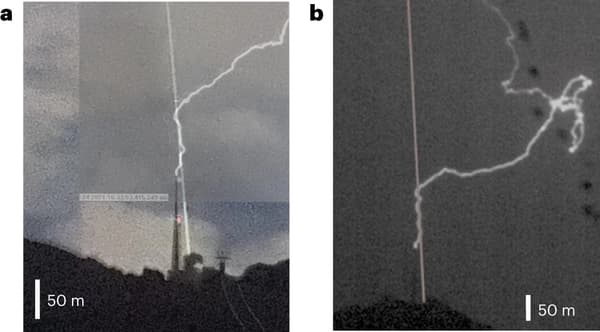Guide ray: this is the bet of the scientists who have provided the first experimental demonstration, according to a study published this Monday in the journal Nature. They managed to direct it with a laser on top of a Swiss mountain.
“We wanted to make a first demonstration that the laser can influence the beam, and the easiest thing is to guide it,” Aurélien Houard, from ENSTA-Ecole Polytechnique’s Applied Optics Laboratory in the Paris region, told AFP.
These results are the culmination of a twenty-year collaboration with physicist Jean-Pierre Wolf, from the Applied Physics Group at the University of Geneva, and involving six institutes.
Since the invention of the lightning rod attributed to Benjamin Franklin in the 18th century, science has made little progress in lightning protection. Only higher and higher masts were built to guide the beam.
Create “a preferential path for lightning”
The solution? They found it on top of Mount Säntis, 2,500 m above sea level in the pre-alps of north-eastern Switzerland. The icing on the cake, the place is equipped with a 124 m high telecommunications tower, struck with almost clockwork regularity at the rate of one hundred lightning strikes a year.
As a reminder, lightning is a discharge of static electricity that has built up between thunderclouds or between thunderclouds and the Earth.
Aurélien Houard and Jean-Pierre Wolf’s team used a laser as a lightning rod. Its beam creates a plasma, air charged with ions and electrons, which is also heated by this process. The air traversed by the beam “becomes then partially conductive and therefore a preferential path for the rays”, a bit like a cable, explains Aurélien Houard.

After two years of building a very powerful laser, manufactured by the German Trumpf, and several weeks to assemble it in pieces in a cable car, the largest helicopter in Switzerland has deposited some containers there to house a telescope. The telescope is used to focus the laser beam to obtain the strongest intensity at 150 meters high. The green laser beam ranges from a diameter of 20 cm at first to a few centimeters.
In the summer of 2021, the scientists tuned their laser to create a plasma over the top of the tower. And he managed to photograph the orientation of a lightning bolt by the laser for about 50 meters. Three other orientations were corroborated by interferometry measurements.
“The first to connect with the cloud”
Lightning develops with precursors (similar to branches) that start from the clouds and the ground when the electric field is strong enough. It is through the union of these precursors that “the current and power of lightning really appear, once the earth is connected to the cloud”, explains Aurélien Houard.
The laser guides one of these precursors. Thanks to this, “it will go much faster than the others and straighter. It will then be the first to connect with the cloud before lighting up. In the end, this forerunner becomes the lightning bolt.
Once the demonstration that lightning can be guided has been made, it remains to be confirmed with other experiments. And then try to shoot lightning bolts, to better protect strategic facilities, such as airports or rocket launch pads. In theory, it would be enough to start precursors and, in practice, to have a fairly high conductivity in the plasma, which the researchers do not believe they have mastered yet.
Scientists unsuccessfully tested the laser theory during a campaign in New Mexico in 2004. The fault was a poorly matched laser and terrain where it is difficult to predict where the beam will strike.
Lightning strikes, which strike 40 to 120 times per second around the world, cause more than 4,000 deaths each year and economic damage amounting to billions of dollars, the study notes.
Source: BFM TV

